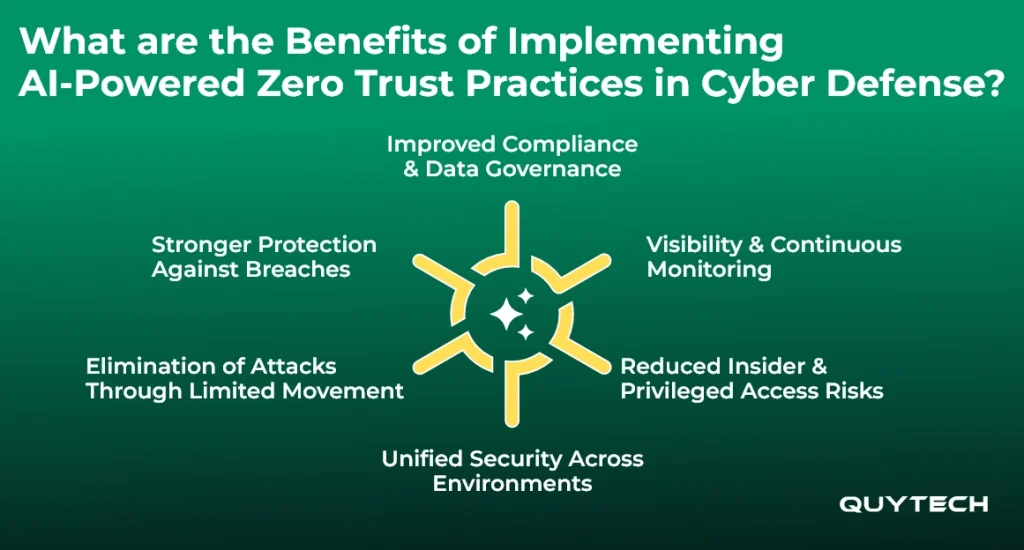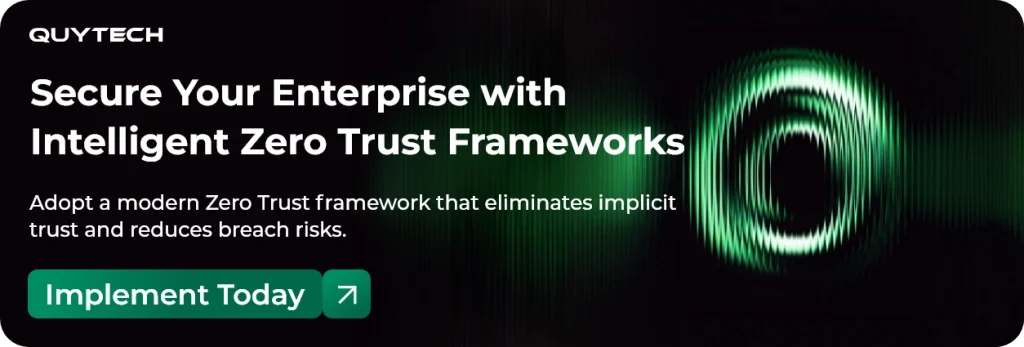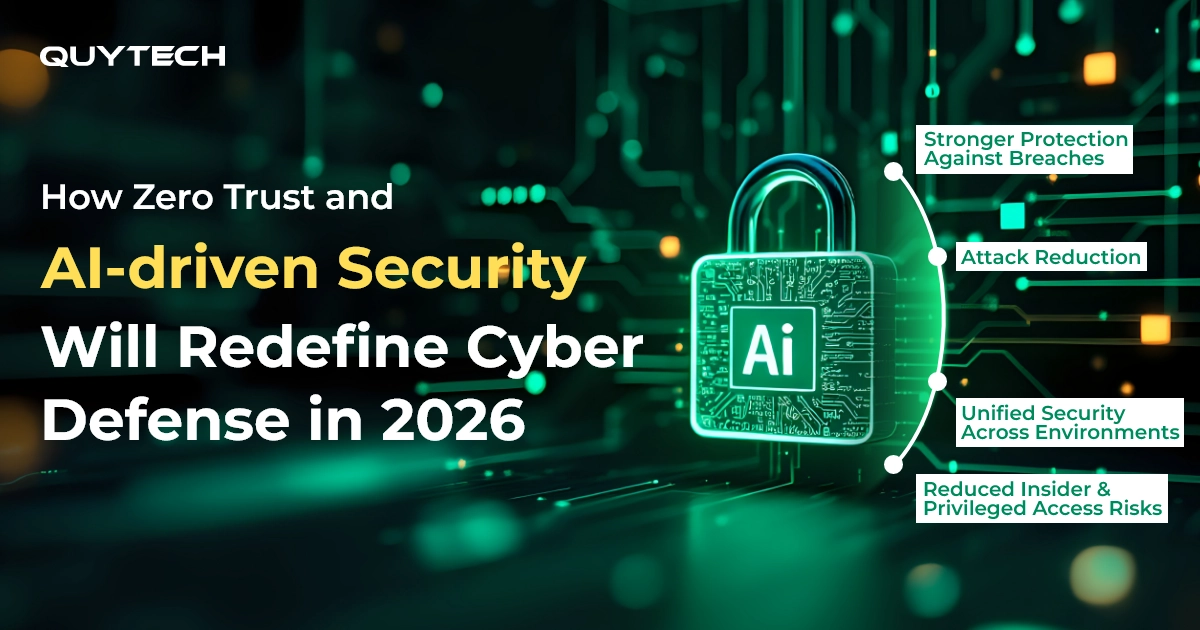Key Takeaways:
- Zero-trust architecture is a security system that works by verifying every user, device, and request.
- The core pillars of zero trust include identity and access management, device health validation, least privilege access, and microsegmentation.
- The need for zero trust arises as traditional security systems fail to tackle the evolving cyber threats.
- The applications of AI-powered zero-trust include anomaly detection, automated access decisions, device health monitoring, and autonomous threat response.
- AI-powered zero trust boosts protection, limits movement, unifies security, reduces insider risks, and ensures compliance.
The times have changed drastically over the years. Cyber threats that once meant virus and malware attacks have now evolved to voice phishing, cyber attacks, and data breaches. All these threats are so advanced that traditional security systems no longer defend networks. All these challenges and limitations create a need for a smarter cyber defense system.
This is where zero-trust comes into play. With an approach that trusts nobody, be it someone inside or outside the network, zero-trust creates a layer that prevents cyber attacks. It eliminates the default trusting approach to one that relies on multiple-factor authentication, identity management, and continuous activity tracking. But beyond the principle of “trust nobody,” how does Zero Trust redefine cyber defense strategies of an organization?
If that’s what you’re wondering, then you are at the right place. This blog will explain everything from what zero trust is to why organizations need it.
What is Zero Trust?
Zero-trust is a security model that pertains to the idea of verification before allowing data or network access to parties. It is a transformative advancement, redefining cyber defense practices. Instead of relying on internal trust, a zero-trust architecture treats every connection as potentially risky and verifies it.
The rise in data and network security threats has paved the way for zero-trust security architecture. It is based on the idea that every application, device, or user should not be automatically granted access to data, as every possible connection is equally potent for cyber risks, no matter if it’s an internal or external source. It does not follow the traditional perimeter-based security models of whatever is inside an organization is trustworthy automatically.
Core Pillars of Zero Trust Security Architecture
To get a better understanding of the concept of zero-trust security architecture, it’s important to understand its core pillars. So here’s a dedicated explanation of the core pillars of zero trust architecture:

Identity and Access Management (IAM)
The identity access management component in a zero-trust security architecture works on managing identity and access. It carries out multiple-factor authentication to verify that only authorized entities get access to resources. IAM does not grant access to an entity just on the basis that it had access earlier; verification takes place every time access is requested.
Device Posture Validation
The device posture validation component carries out the task of analyzing the health of devices seeking access to resources. It ensures that the device requesting access is secure, compliant with regulatory requirements, and is free of potential risks of malware. You can think of device posture validation as a health checkup component.
Least Privilege Access
The least privilege access component focuses on allowing the minimum access to the entity requesting it. It does so to ensure that the device or user accessing the resource gets access to only those areas where it needs to work. With limited access, data is protected from user exploration.
Micro Segmentation
Microsegmentation refers to segmenting the network into bits instead of protecting it as a whole. This creates a strong layer of security. Even if a device gets access to one segment, it won’t be able to access the entire network as it’s protected by microsegmentation.
Continuous Monitoring and Analytics
Zero-trust security architecture does not remain static after granting access to a device following verification. It continuously monitors and tracks the activities the device carries out. This tracking enables the detection of user behavior anomalies and allows for the taking of corrective actions in real-time. If it encounters abnormal behavior, it will adjust access levels accordingly.
Why Do Organizations Need a Zero Trust Cyber Defense Model
Just knowing the core pillars is not enough to understand the role zero-trust plays in redefining cyber defense. So here’s a dedicated section explaining why organizations need a zero-trust cyber defense model:
Traditional Perimeter Security No Longer Works
In the traditional cyber defense scenario, everyone inside the organization is trusted by default. But this does not work in the current scenario. The current times include people working remotely and freelancing. This means that perimeter-based security does not work anymore because not every employee is inside the perimeter, naturally raising cybersecurity concerns.
Rising Credential Theft and Account Compromises
The rising threats of credential theft and account comprises are yet another reason to upgrade cyber defense models. The traditional cyber defense models follow this approach, where if the user logging in has the right credentials and passwords, it allows them access to resources. It fails to address the risks of credential theft and blindly allows access without in-depth verifications.
Increased Risk of Insider Threats
As mentioned already, traditional cyber defense practices believe that a person inside the network is trustworthy by default. This approach fails to address the chances of insider threats, where a user inside the network can compromise the security of resources, whether intentionally or unintentionally. Naturally reflecting the need for smart cybersecurity models.
Lateral Movement Threats
With traditional cyber defense practices, lateral movement threats are not addressed effectively. Since the traditional approach pertains to believing whatever is inside the network is safe, a minor breakthrough can compromise the security of the whole network. And, the automatic trust in insider access makes the traditional security system incapable of protecting the network.
Blind Spots in Cloud and Multi-Cloud Environments
Traditional security systems are usually hosted on premises, which fail to control access and security over cloud platforms used. It means that the security systems of the organization won’t be able to track and detect threats occurring on cloud platforms. Naturally, this reflects the need for a smarter cyber defense system.
Use Cases of the AI-Powered Zero Trust Model
AI for zero-trust models brings in intelligence, automation, and real-time decision-making ability. You can think of the zero-trust model as a capable structure, and AI as its driving key. But where does AI-powered zero-trust architecture apply? Well, that’s what we have covered below:
Automated Anomaly Detection
AI-powered zero-trust model tracks how a device or user is interacting and behaving with resources. It makes use of machine learning and anomaly detection models to automate activity analysis and anomaly detection. AI integration trains systems to classify normal and abnormal activities accurately.
Predictive Risk-Based Access
Integrating AI in a zero-trust architecture transforms the reactive approach of cyber defense into a proactive one. It analyzes the device health, past activities, and behavior of the user or device. If these factors do not match the standards, AI monitors their activity to limit or cancel their access to resources proactively.
Automated Access Decisions
AI for zero-trust models automates the access decisions for devices or users requesting access. It does so by evaluating the risk factor of each device/user and allotting and limiting access accordingly. AI automates the multiple-factor authentication steps, making the process quicker and smarter.
Continuous Device Health Monitoring
As explained earlier, zero-trust architecture does not conduct verifications only when granting access. Instead, it tracks the entity throughout its existence in the network. And how does it do so? Yes, you guessed it right! With the help of AI. It conducts continuous device health and activity monitoring with the help of AI.
Intelligent Micro-Segmentation
In the micro-segmentation areas, AI-powered zero-trust architectures make the process of segmenting intelligent. It does so by analyzing the patterns in which applications are interacting with each other within the network. If it detects something that is not usual, it adjusts micro-segmentation automatically. It creates a wall that prevents attackers from exploring the network.
Autonomous Threat Response
As mentioned above, AI is capable of detecting threats, but it does not stop just there. AI-powered zero-trust security systems can take protective measures. It does so by utilizing machine learning, automated response, and real-time analytics engines. AI can isolate the user and freeze their access to prevent harm.
Remote Work Security
AI-powered zero-trust security systems validate access requests for users working remotely. It analyzes risks associated with each user, their access privilege, and monitors their activity. With real-time analytics, AI blocks untrusted devices, ensuring resources are protected.

How Zero Trust + AI-Driven Security Works?
Now that you are aware of the role AI plays in zero-trust security architecture, the next concept to explore is the working mechanism. So, here’s a section explaining how AI-powered zero-trust security works:
Step 1: Access Request Reception
The working mechanism of a zero-trust security system begins when a user or device requests access. Zero-trust security treats every request as new, regardless of how many times the device has accessed the network. Identity & access management, as well as multi-factor authentication, occur in this step.
Step 2: AI-Driven Risk Evaluation
Once authentications are performed, the next step focuses on evaluating the risks associated with the device. AI performs the risk evaluation by checking the health of the device, past activity patterns, locations, etc. Machine learning and device posture assessment tools play the roles here.
Step 3: Least-Privilege Access Enforcement
After risks are evaluated, the next step zero trust takes is providing least-privilege access. This means that it will allow access to the user to areas that are related to their work. It does not allow users to explore areas other than what is requested. Role-based access controls support this step.
Step 4: Continuous Monitoring & Anomaly Detection
AI-based zero-trust architecture does not stop at access approvals; it goes beyond them by continuously monitoring the activities done by the user/device. Zero trust makes use of real-time analytics and anomaly detection models in this step. This enhances preparedness against anomalies.
Step 5: Automated Threat Response and Containment
As mentioned already, user/device activities are monitored continuously, which makes it easy for a zero-trust architecture to automate responses. These responses immediately isolate the device from the network, limit its access, and block further activities.
Step 6: Lateral Movement Prevention and Policy Adaptation
Even if a device/user gets in through a loophole, zero trust freezes its lateral movements. This means that while the device has access to a certain segment of the network, it won’t be able to get into the rest of it. Along with this, AI adjusts the policies of access to ensure the user doesn’t get more privileges inside the network.
What are the Benefits of Implementing AI-Powered Zero Trust Practices in Cyber Defense?
Implementing AI-powered zero-trust practices benefits organizations in multiple ways. It helps them protect their data from breaches, eliminates attacks, and a lot more. Here’s a section that will help you dive deeper into the benefits of implementing AI-powered zero-trust in cyber defense:

Stronger Protection Against Breaches
AI-powered zero-trust helps organizations gain stronger protection against breaches. It does so by analyzing the behavior of devices accessing the network. Zero-trust limits flagged users/devices from further exploring the data and limits their access to the network.
Elimination of Attacks Through Limited Movement
In case a user does get access to the network, AI-powered zero-trust limits their movement across the network. It identifies suspicious activities inside the network with the help of continuous monitoring systems. This helps in recognizing anomalies and restricting users from accessing the resources.
Unified Security Across Environments
In traditional cyber defense systems, securing different environments was a challenge. This was so because an on-premise system was not capable of protecting cloud environments. But with AI-powered zero-trust, organizations can protect their network and data across environments without struggles.
Reduced Insider & Privileged Access Risks
With traditional cybersecurity, a user inside the network is automatically trustworthy. This practice often made organizations vulnerable to insider cyber attacks. But with AI-powered zero-trust, every user is treated equally and granted trust only after they prove to be risk-free. This eliminates the chances of privileged access risks.
Visibility & Continuous Monitoring
Conventional cyber defense failed to continuously monitor user activities. It was not capable of proactively tracking users; it took action only after incidents occurred. AI-powered zero-trust practices introduce continuous visibility and monitoring that allows organizations to track user activities throughout their presence in the network.
Improved Compliance & Data Governance
AI-powered zero-trust helps organizations in reinforcing regulatory compliance. It does so by tracking data-related movements, access logs, and activity audits. This allows organizations to maintain data governance and comply with regulatory requirements without much hassle.
Challenges and Best Practices for Implementing Zero Trust Security
While implementing zero-trust security brings in immense benefits for organizations, its implementation process has its own share of challenges. But worry no more! Because we will guide you through these challenges. Here’s a list of challenges and best practices for implementing zero trust security:
Incompatibility with Legacy Systems
A very common challenge that organizations face when implementing zero-trust architectures is incompatibility with legacy systems. Many organizations have outdated existing systems, which, when blended with sophisticated ones, can turn out to be highly incompatible.
Best Practices
For a better implementation experience with legacy systems, organizations can opt for AI-based integration. This will allow organizations to upgrade without upgrading existing systems.
Cultural and Operational Resistance
While organizations may manifest upgradation, cultural and operational resistance may create a hurdle in the implementation process. This can lead to a slow implementation process or resistance from within the organization.
Best Practices
To tackle cultural and operational resistance, organizations should spread awareness about the concept of zero-trust architectures and how it is a long-term security strategy. Training employees and reflecting on the usability of zero-trust also contribute to a smoother implementation journey.
High Implementation Costs
Another factor that creates a sense of hesitance in organizations is the high implementation costs. Implementing zero-trust requires network architecture, security systems, monitoring tools, and governance frameworks. The costs spent on all these may look too significant to organizations, making them hesitant investors.
Best Practices
Organizations should understand that the high costs of implementation come with a long-term value as well. Along with this, organizations can opt for phased implementation for cost efficiency.
Conclusion
As cybersecurity threats peak, organizations face data and network safety challenges. But with AI-powered zero-trust security models, organizations not just become stronger, but also compliant. Zero trust introduces components like identity access management, device posture validation, least privilege access, and microsegmentation. These components not only make the network and resources protected but also add automation by integrating artificial intelligence.
With benefits like stronger protection against breaches, limited movement, unified security, and improved compliance, AI-powered zero-trust architecture is redefining cyber defense for the future. By blending AI with zero-trust, organizations can step into 2026 with a security foundation designed not just to respond, but to stay resilient.

FAQs
No, zero-trust is not limited to just large enterprises. Small businesses can also implement it and protect their network and resources.
Zero-trust security system does not replace firewalls. Instead, it strengthens them by controlling access. Its continuous monitoring and multi-factor authentication add to the layer of security.
Yes, zero-trust is not just possible but ideal for fully remote or hybrid work environments. It ensures that people connect through different places and devices without compromising security.
Yes, zero-trust does help organizations in meeting compliance requirements. It does so by enforcing identity controls, access governance, and continuous monitoring.
Not necessarily, companies with limited technical infrastructure can implement zero-trust by hiring dedicated developers.
For unmanaged or personal devices, AI-powered zero-trust plays its role by evaluating the trustworthiness of every device accessing the network.
No, zero-trust does not slow down workflows. It automates the authentication tasks in the initial stages and monitors devices, which eliminates the need for constant authentication.
Yes, zero-trust can be implemented gradually; it does not require a full transition. Its gradual adoption cycle is what makes it stand out.
